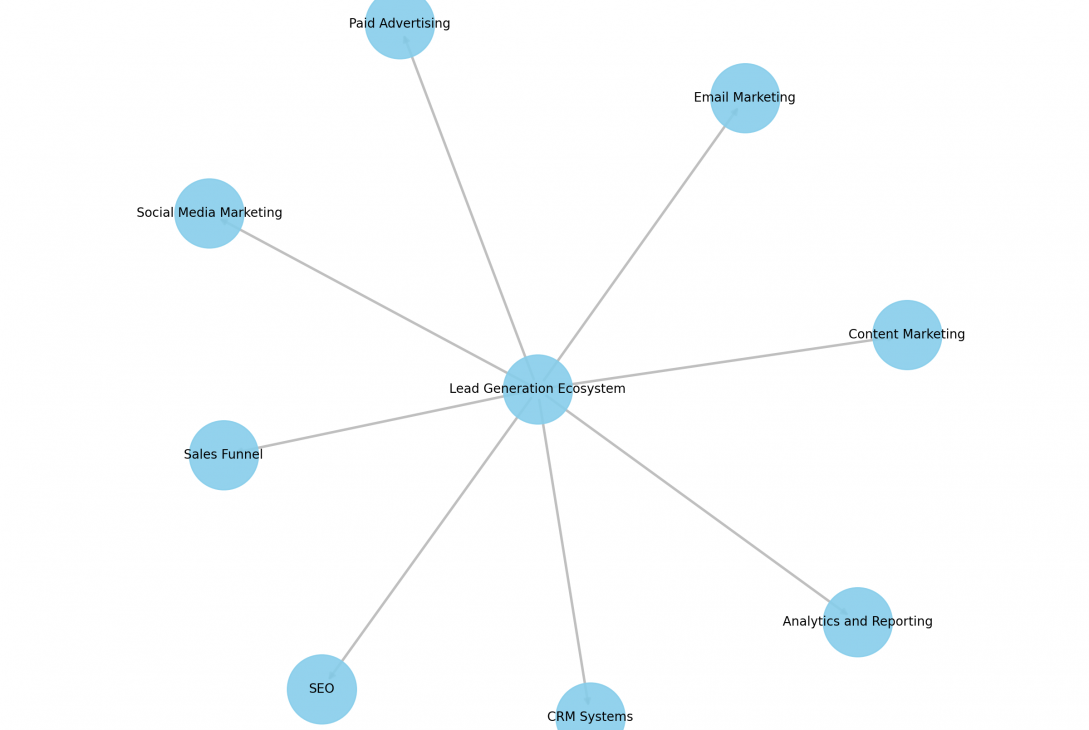Mastering lead generation is crucial for sustainable growth and success in today’s competitive business landscape. A well-structured lead generation ecosystem can transform your marketing efforts, driving qualified prospects to your business and nurturing them into loyal customers. Let’s dive into the key components of an effective lead generation ecosystem and how they work together to fuel your sales pipeline.
The Foundation: Multiple Traffic Sources
The journey begins with attracting potential customers through various channels:
1. Social Media Platforms: Leverage the power of Facebook, LinkedIn, Instagram, and YouTube to engage your target audience, build brand awareness, and drive traffic to your website.
2. Display Networks: Utilize platforms like Google Display Network and other ad networks to expand your reach across the web, placing targeted ads on relevant websites to capture interest.
3. Search Engines: Harness the potential of Google, Bing, and Yahoo through a combination of search engine optimization (SEO) and pay-per-click (PPC) advertising to appear in front of users actively seeking your products or services.
The Hub: Your Company Website
Your website serves as the central nervous system of your lead generation efforts. It should offer a rich array of content and resources designed to inform, engage, and convert visitors:
– eBooks and whitepapers
– Product information and services details
– Podcasts and video content
– Free tools and resources
– Webinars and product demonstrations
– Case studies and success stories
– Blog articles and thought leadership pieces
This diverse content mix caters to different stages of the buyer’s journey, providing value and encouraging visitors to take the next step.
Capturing Leads: Multiple Touchpoints
Implement various methods to capture lead information:
1. Phone Calls: Enable direct contact for immediate engagement.
2. Form Submissions: Offer gated content or contact forms to collect visitor information.
3. Live Chat: Provide real-time assistance and capture leads through conversations.
ALSO READ: A Roadmap to Becoming a Front-End Web Developer
Managing Leads: CRM Integration
Integrate all lead capture methods with your Customer Relationship Management (CRM) system. This allows you to:
1. Categorize leads as validated or requiring further qualification.
2. Forward qualified leads to your sales team for follow-up.
3. Track lead progress through the sales funnel.
The Sales Process: Conversion and Beyond
Your sales team works to convert leads into customers. This process typically results in two outcomes:
1. Lead Closed: Successfully converted into a paying customer.
2. Lead Not Closed: Requires further nurturing or may not be a good fit at this time.
Nurturing Leads: Marketing Automation
For leads that aren’t ready to convert immediately, implement a robust marketing automation strategy:
– Email Campaigns: Deliver targeted, personalized content to nurture leads over time.
– SMS and Messaging Apps: Use platforms like WhatsApp for more direct, immediate communication.
– Content Marketing: Continuously engage leads with relevant blog posts, articles, and resources.
– Retargeting: Use display ads to keep your brand top-of-mind for leads who’ve shown interest.
Optimizing Your Ecosystem
To maximize the effectiveness of your lead generation ecosystem:
1. Continuously analyze performance data across all channels and touchpoints.
2. A/B test different elements of your website, ads, and email campaigns.
3. Refine your ideal customer profile and targeting strategies.
4. Invest in training for your sales and marketing teams to improve lead handling and conversion rates.
5. Stay updated on industry trends and emerging technologies to maintain a competitive edge.
A well-implemented lead generation ecosystem is a powerful engine for business growth. By integrating multiple traffic sources, creating valuable content, implementing effective lead capture methods, and utilizing smart nurturing strategies, you can create a steady stream of qualified leads for your business. Remember, the key to long-term success lies in continuous optimization and adaptation to meet the evolving needs of your target audience.


















 and then
and then